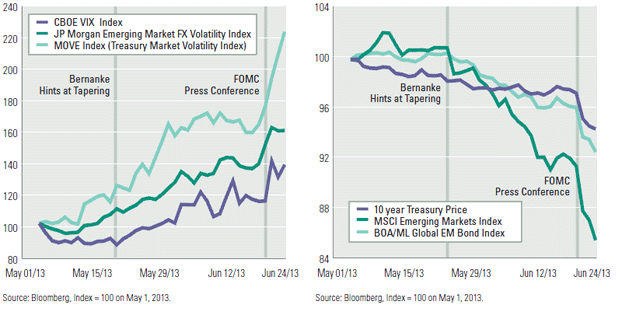Have we lost control yet?
Eric Sprott and Etienne Bordeleau, Sprott Asset Management
Recent comments by the Federal Reserve Chairman Ben Bernanke have shocked the world financial markets. It all started on May 22nd, 2013, at a Testimony to the US Congress Joint Economic Committee, where he first hinted at tapering the Fed’s quantitative easing (QE) program. Then, on Wednesday, June 19th, during the press conference following the FOMC meeting, the Chairman outlined the Fed’s exit strategy from QE.
Since the first allusion to tapering, volatility has been on the rise across the board (stocks, currencies and bonds) (Figure 1A). Moreover, the yield starved, hot money that had flown to emerging markets has been rushing for the exits, triggering significant declines in emerging market (EM) equity and bond markets (Figure 1B). Finally, the prospect of the end of monetary accommodation has triggered rapid and significant decreases (increases) in the price (yield) of longer dated Treasury bonds (also Figure 1B).
FIGURE 1A: VOLATILITY INCREASING FIGURE 1B: ASSET PRICES DECLINING

It has been clear to us for some time that the Fed was uncomfortable with the relative certainty (i.e. Bernanke Put) that has prevailed in the markets since the introduction of QE-infinity last fall. Officials definitely wanted the market to start thinking about a future without non-conventional monetary policy. However, we seriously doubt that the resulting chaos is what they had anticipated. This was evident in the Chairman’s response to a journalist’s question about the rapid rise in rates, saying the FOMC was “a little puzzled by that”.1 The genie is really out of the bottle now.
Indeed, we believe that the recent “market appeasement rhetoric” by James Bullard and Narayana Kocherlakota (Presidents of the St. Louis and Minneapolis Federal Reserve, respectively)2,3 are further proof that the Federal Reserve has realized it went too far and that it is now in damage control mode. (Update: William Dudley, President of the New York Fed mentioned in a June 27th speech that “asset purchases would continue at a higher pace for longer” if the economy was to grow slower than the FOMC’s estimate)4.
However, as the Bank for International Settlements (BIS) so elegantly put it in its most recent annual report, “[…] central banks continue to borrow time for others to act. But the cost-benefit balance is inexorably becoming less and less favourable.” To this they add: “expectation that monetary policy can solve these problems [deleveraging, financial stability] is a recipe for failure”.5 Clearly, the Federal Reserve knows this and wants to exit their QE program. But can they really?
A large portion of the current economic growth depends on housing. However, mortgage rates are closely tied to long-term treasury rates. While housing affordability is still relatively good because of low house prices, significantly higher mortgage rates might slow the housing market. Furthermore, banks are still very cautious about lending and most borrowers have difficulty accessing credit. While gentle increases in yields are good for banks (who lend long and borrow short), meteoric increases in yields (as in Figure 1B) are damaging because they are hard to hedge and create large losses on the banks securities portfolios (mostly composed of government bonds and mortgage-backed securities) as well as mark-to-market losses on their derivatives portfolios. So, the large and rapid increases in rates the talk of tapering has engendered will damage the economic growth the Fed has been working so hard to engineer, potentially requiring even more stimulus down the line.
The US government itself would also suffer from increases in yields. In its Annual Report, the BIS shows that even a small increase in interest rates would have a large impact on the projected government debt-to-GDP ratio. As shown in Figure 2, under the CBO’s base case scenario (bottom line), the US debt-to- GDP ratio would hover around 110%, whereas a 1% increase in rates would take it to 118% in 10 years (middle line). According to the Chairman’s comments, the fiscal drag that has been partly to blame for the lackluster performance of the economy should subside going forward. But, larger debt servicing costs (because of higher rates) will put more pressure on government finances, forcing it to spend an ever increasing portion of its budget on interest payments. This will have the effect of increasing the fiscal drag, going against the hopes of the Fed.
FIGURE 2: U.S. GENERAL GOVERNMENT DEBT PROJECTIONS UNDER ALTERNATIVE SCENARIOS - AS A PERCENTAGE OF GDP
 Sources: IMF; OECD; US Congressional Budget Office; BIS calculations.
Sources: IMF; OECD; US Congressional Budget Office; BIS calculations.
To add to all this uncertainty, the situation in the Euro Zone’s periphery is far from stabilized. Following the surprise Cyprus bail-in, international bank regulators have made a push for a democratization of this alternative to outright government bail-outs of banks. This idea is quickly gaining traction amongst central planners. We recently discussed the shortcomings of the BIS’s “Template For Recapitalising Too-Big-To- Fail Banks”.6 The BIS, again in its annual report, reiterated that “we need resolution regimes to make it possible for large, complex institutions to fail in an orderly way.” As uninsured depositors and bank bond holders realize that they do not benefit from government guarantee anymore, bank funding costs will rise and funding might dry up for peripheral European banks.
Conclusion: at the last FOMC meeting, by prematurely announcing the timeline and the specifics of an exit from QE, Bernanke might have lost control of rates and volatility. The current US economic growth is still feeble and hinges on housing, which would be slowed down by raising rates. Banks, while better capitalized than pre-crisis, are still not lending to most borrowers and would be dearly affected by too fast increases in rates. Moreover, European woes still threaten the stability of the international financial system and the recent rush to the exit might further exacerbate funding pressures for weak European banks. Finally, the US government (amongst others) debt load, while already unsustainable, would keep on climbing if rates were to increase only by 100bps.
The chaotic reaction by market participants and the corresponding increase in yields now risks destabilizing this very fragile equilibrium. It is yet unclear whether or not the damage control from the other Fed Presidents will put a lid on yields and market volatility, or if the damage to the Fed’s (poorly executed) exit strategy is permanent.
Footnotes:
1. http://www.federalreserve.gov/mediacenter/files/FOMCpresconf20130619.pdf
2. http://www.stlouisfed.org/newsroom/displayNews.cfm?article=1829
3. http://www.minneapolisfed.org/publications_papers/pub_display.cfm?id=5128
4. http://www.bloomberg.com/news/2013-06-27/dudley-says-qe-may-be-prolonged-if-economy-misses-fed-forecasts.html
5. 83rd Annual Report, Bank for International Settlements, Basel, 23 June 2013, pages 4 and 6.
6. We discuss this in the Sprott Thoughts article: “The Dijssel_Bomb”. http://sprottgroup.com/thoughts/articles/the-dijssel-bomb/













